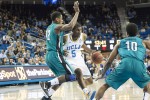UCLA men’s basketball’s biggest difference this season is just that: the difference in its bigs.
With their four most-played frontcourt players – freshman forward Kevon Looney, sophomore forward Wanaah Bail, junior forward/center Tony Parker and freshman center Thomas Welsh – possessing wingspans of 6 feet 11 inches or larger, the Bruins’ length is its most noticeable asset this season.
“Last year, (we had) versatility in the backcourt,” said coach Steve Alford. “Now our frontcourt is where our versatility is, so that’s what we’re learning as coaches as well as the lineups: the different things that we can do when we do go long.”
The most immediate impact that UCLA’s new length has had in its first two games is on the defensive end. While Alford said the defense as a whole needs to improve, he added that his team’s zone defense has been “very good.”
With so many players with long wingspans, the Bruins’ zone has become increasingly more difficult to score against. Compounding that is the new 1-3-1 zone that the Bruins are playing, which the Bruins are implementing this year after not running it at all last season.
“All teams have a bunch of plays for man, they have a few plays for zone, but usually you’re not gonna see a 1-3-1. Not too many teams run a 1-3-1, and if they do, they don’t do it very often,” said sophomore guard Bryce Alford. “So playing against a 1-3-1, you don’t have a whole lot of sets that you run, so it takes away a lot of what teams prepare for.”
The unusual style of zone defense is enough to limit the opposing offense’s options, but using a 1-3-1 with the length that the Bruins have complicates matters even more for UCLA’s opponents. The Bruins, with long arms everywhere, are able to close off passing lanes and block shots with relative ease.
“(When) you have Kevon Looney at the top of the 1-3-1 with a (7-foot-3-inch) wingspan, it’s really hard to make your passes and get your shot off and things like that,” said senior guard Norman Powell. “And me – (6-foot-11-inch wingspan) – Wanaah (has a) 7-foot wingspan, and we got a (6-foot-9-inch player) in the paint, Tony, with a great wingspan, so it really helps our defense.”
The Bruins’ abundance of players with huge wingspans is abnormal in college basketball. Adding to Powell’s list, Welsh also sports a 6-foot-11-inch wingspan to go with his 7-foot frame, according to his measurements on DraftExpress.com.
But it’s Looney’s 7-foot-3-inch wingspan – four inches longer than that of Welsh, who stands three inches taller than Looney – that has been the most intriguing in his first two collegiate games. From his ability to play at any spot in the zone defense to his rebounding prowess, Looney’s length plays a key role in all his strengths as a player.
“It’s crazy. I don’t understand it,” Powell said. “He doesn’t have to jump for rebounds; he doesn’t have to jump to dunk.”
Averaging 11.5 rebounds through the first two games, Looney’s ability to impact the game on the boards has been a main story line in UCLA’s young season. But Looney credits his rebounding prowess to more than just his long arms; his instinctual feel for where the ball will end up is key to his success.
“If someone taught me, I would say it’s my brother,” Looney said. “When I used to go to the park with him, he shot all the shots and he missed a lot of them, so I just learned how to get rebounds.”
